博文
[转载]python Marker reference
|||
Matplotlib supports multiple categories of markers which are selected using
the marker parameter of plot commands:
For a list of all markers see also the matplotlib.markers documentation.
For example usages seeMarker examples.
import matplotlib.pyplot as pltfrom matplotlib.lines import Line2Dtext_style = dict(horizontalalignment='right', verticalalignment='center', fontsize=12, fontfamily='monospace')marker_style = dict(linestyle=':', color='0.8', markersize=10, markerfacecolor="tab:blue", markeredgecolor="tab:blue")def format_axes(ax): ax.margins(0.2) ax.set_axis_off() ax.invert_yaxis()def split_list(a_list): i_half = len(a_list) // 2 return a_list[:i_half], a_list[i_half:]
Unfilled markers
Unfilled markers are single-colored.
fig, axs = plt.subplots(ncols=2)fig.suptitle('Un-filled markers', fontsize=14)# Filter out filled markers and marker settings that do nothing.unfilled_markers = [m for m, func in Line2D.markers.items()
if func != 'nothing' and m not in Line2D.filled_markers]for ax, markers in zip(axs, split_list(unfilled_markers)):
for y, marker in enumerate(markers):
ax.text(-0.5, y, repr(marker), **text_style)
ax.plot([y] * 3, marker=marker, **marker_style)
format_axes(ax)plt.show()The edge color and fill color of filled markers can be specified separately.
Additionally, the Use MathText, to use custom marker symbols,
like e.g. Any 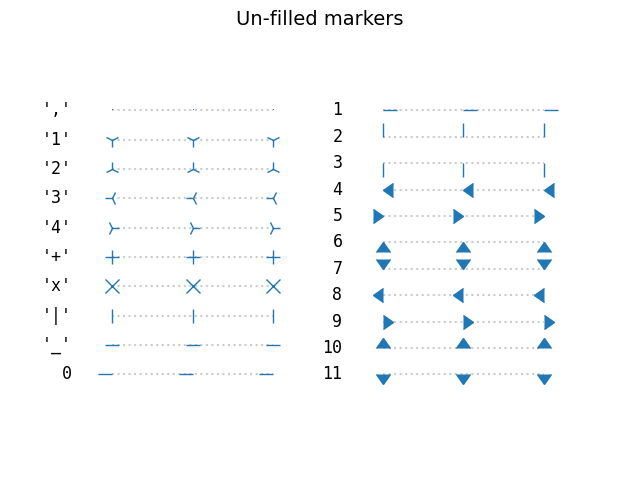
Filled markers
fig, axs = plt.subplots(ncols=2)fig.suptitle('Filled markers', fontsize=14)for ax, markers in zip(axs, split_list(Line2D.filled_markers)):
for y, marker in enumerate(markers):
ax.text(-0.5, y, repr(marker), **text_style)
ax.plot([y] * 3, marker=marker, **marker_style)
format_axes(ax)plt.show()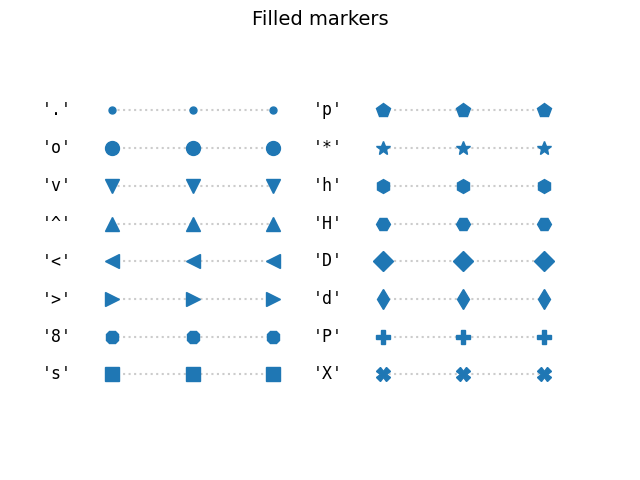
Marker fill styles
fillstyle can be configured to be unfilled, fully
filled, or half-filled in various directions. The half-filled styles usemarkerfacecoloralt as secondary fill color.fig, ax = plt.subplots()fig.suptitle('Marker fillstyle', fontsize=14)fig.subplots_adjust(left=0.4)filled_marker_style = dict(marker='o', linestyle=':', markersize=15,
color='darkgrey',
markerfacecolor='tab:blue',
markerfacecoloralt='lightsteelblue',
markeredgecolor='brown')for y, fill_style in enumerate(Line2D.fillStyles):
ax.text(-0.5, y, repr(fill_style), **text_style)
ax.plot([y] * 3, fillstyle=fill_style, **filled_marker_style)format_axes(ax)plt.show()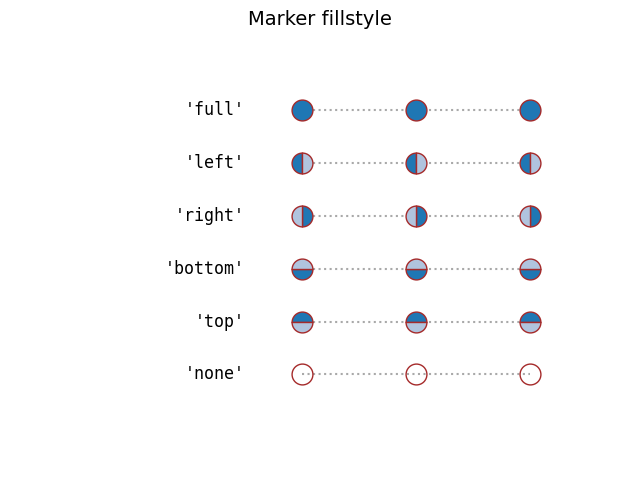
Markers created from TeX symbols
"$\u266B$". For an overview over the STIX font symbols refer
to the STIX font table.
Also see the STIX Fonts.fig, ax = plt.subplots()fig.suptitle('Mathtext markers', fontsize=14)fig.subplots_adjust(left=0.4)marker_style.update(markeredgecolor="none", markersize=15)markers = ["$1$", r"$\frac{1}{2}$", "$f$", "$\u266B$", r"$\mathcal{A}$"]for y, marker in enumerate(markers):
# Escape dollars so that the text is written "as is", not as mathtext.
ax.text(-0.5, y, repr(marker).replace("$", r"\$"), **text_style)
ax.plot([y] * 3, marker=marker, **marker_style)format_axes(ax)plt.show()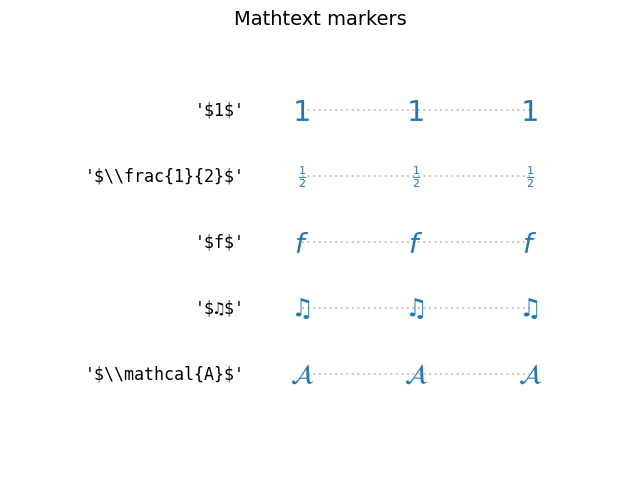
Markers created from Paths
Path can be used as a marker. The following example shows two
simple paths star and circle, and a more elaborate path of a circle with
a cut-out star.import matplotlib.path as mpathimport numpy as npstar = mpath.Path.unit_regular_star(6)circle = mpath.Path.unit_circle()# concatenate the circle with an internal cutout of the starcut_star = mpath.Path(
vertices=np.concatenate([circle.vertices, star.vertices[::-1, ...]]),
codes=np.concatenate([circle.codes, star.codes]))fig, ax = plt.subplots()fig.suptitle('Path markers', fontsize=14)fig.subplots_adjust(left=0.4)markers = {'star': star, 'circle': circle, 'cut_star': cut_star}for y, (name, marker) in enumerate(markers.items()):
ax.text(-0.5, y, name, **text_style)
ax.plot([y] * 3, marker=marker, **marker_style)format_axes(ax)plt.show()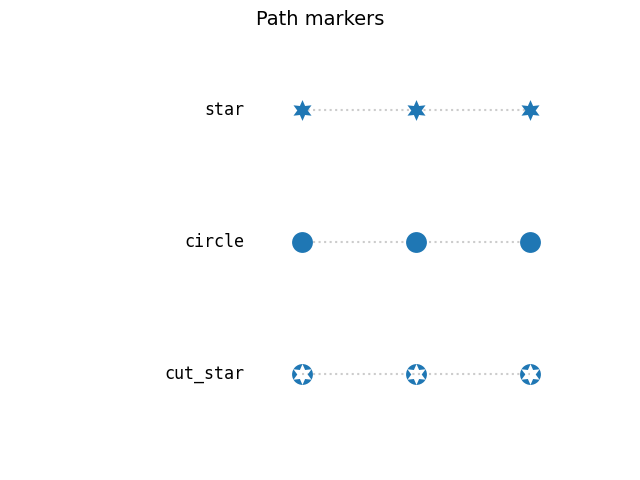
Total running time of the script: ( 0 minutes 1.917 seconds)
Download Python source code: marker_reference.py
Download Jupyter notebook: marker_reference.ipynb
Keywords: matplotlib code example, codex, python plot, pyplot
https://wap.sciencenet.cn/blog-587102-1322005.html
上一篇:[转载]python Bayesian Methods for Hackers style sheet-alpha=0.8
下一篇:[转载]Py-Matplotlib: Plot 如何生成多个子图,以及它们如何共享坐标轴?或者共轴?